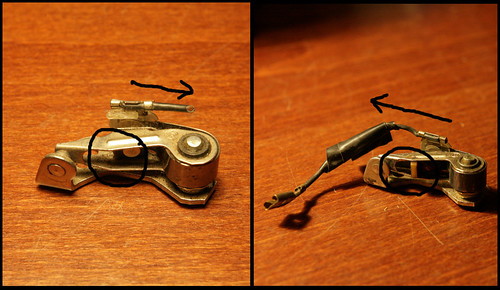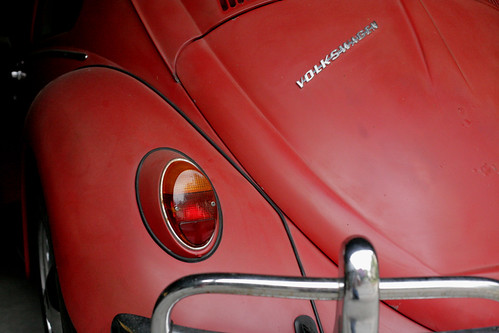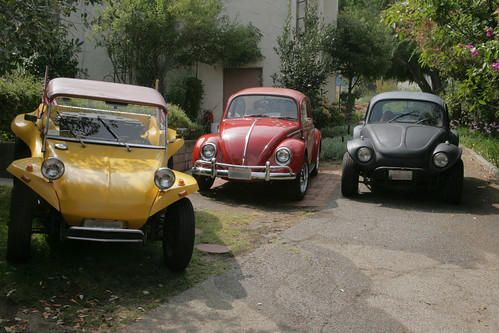 In the early days of 2016, I was experiencing some fuel leaks on my Baja bug. Some of the rubber hoses that I had installed when I first put the thing together had gotten brittle and subsequently had cracked from the vibration of the engine and the rough city streets of Los Angeles. I could smell the gasoline inside the car, but that car always smells of gasoline. Like all air-cooled VWs, the gas tank is in the front and if the gas cap doesn’t seal perfectly or the gasoline splashes around in the tank and spills out of the vent, you smell gasoline in the car. I check it out and notice that the fuel lines were showing some deterioration, especially on the end where the line hooked to the carburetor. The hose seemed okay except for the end, so I just cut off that bit and hooked it back up. Big mistake.
The next evening, as I was driving home from Hollywood, the engine died. I pushed in the clutch and kept rolling forward as I turned the key to try to restart the engine. Someone behind me honked their horn. I looked in the rearview mirror to see what was going on. What I saw were flames coming from the engine compartment of the car. By then the car had stopped rolling forward. I pulled the handbrake, shut off the ignition, unfastened my seatbelt and got out of the car to see what was burning.
The fuel line had failed and the gasoline was burning up the top of the motor. There were several people gathered on the nearby sidewalk. Some of them told me to get away. I didn’t. Instead I opened the passenger door and removed my laptop and other gear from inside the car. I then retreated to the curb and was prepared to dial 911. Someone said that they had already done that and that the fire department was on the way. Since I had failed to carry a fire extinguisher in the car, there was nothing else for me to do at that point but stand with the other spectators and watch it burn. As the wires burned, the starter engaged a number of times. I realized now that I should have disconnected the battery while I was getting my stuff out of the car. The burning gasoline set the fiberglass spoiler on the back of the car on fire. While I stood on the sidewalk with my laptop computer and my lunch pail and watched it burn, I called my wife to let her know that I would be late getting home. About the time that the fire was really getting serious, the fire truck pulled up. I told my wife I’d call her back when the fire was out.
While one of the firefighters sprayed water on the engine fire, another disconnected the battery and ripped the carpet off of the firewall at the rear of the car. The guy tearing out the carpet said it was necessary as the carpet was melting and charring and could burst into flames. Nearly everything got wet before they were done, including the seats, which I discovered a few minutes later when I got into the car to steer it as it was pushed out of the street and into an adjacent parking lot. As I stood there next the car deciding what to do next, a tow truck pulled into the lot.
The tow truck driver and what I believe was his wife offered to tow the car to my house for me. It seemed like a good idea, since I didn’t know how else I would get it home, so I told them to go ahead. They backed up, got the front wheels hooked up to their tow rig and placed a magnetic light bar on the top. When they raised it up, though, fuel started leaking from the fuel line again and was running into the parking lot. I cut off a piece of burned wire, crimped the end of the rubber tube and tied it closed, stopping the fuel leak. The driver now wanted his money for the tow, but he would only take cash. I don’t remember how much he asked for but it seemed like way too much for towing the car just a couple of miles. I told him I’d figure out some other way to get it home and had him unhook his gear. He did, but he left the magnetic light bar on the top of my car. I called my wife again, to let her know that the fire was out and to have her bring a tow chain to we could drag the thing home. She reminded me that we had bought her an AAA membership which we could use to get the car towed home. I had her call AAA and arrange it and then drive over so that she would be present when the AAA driver showed up since she’s the membership holder and not I.
While I waited for my wife and/or the tow truck to arrive, I retrieved all the wet carpet and other scorched car parts from the street where the firefighters has put them and loaded them into the car. I figured I might need some of them later. As I was doing that, I noticed the abandoned magnetic light bar still attached to the top of the car. I didn’t want it, so I took it off the car and set it on the pavement next to the car. It lay there blinking. I figured if the tow truck driver from earlier missed it, he could pick it up where I had left it. He never came back. Eventually, a homeless guy took the still brightly shining light bar and added it to the pile of stuff in the shopping cart he was pushing.
My wife showed up and soon thereafter, the tow truck she had requested showed up as well. We had them drop the car in my driveway. I rolled it down the drive and backed in into a parking spot near the back door. I left it there for quite a while before I got around to inspecting it to see what the extent of the damage was. It wasn’t as bad as it appeared that night, but I’ll save that story for the next episode.
Lessons learned: Always carry a fire extinguisher in the car. Be more diligent in inspecting the condition of the fuel lines. Use metal fuel lines as much as possible. Route the fuel lines so that if they do leak, they don’t drip onto the distributor where sparks can set the gasoline on fire.
In the early days of 2016, I was experiencing some fuel leaks on my Baja bug. Some of the rubber hoses that I had installed when I first put the thing together had gotten brittle and subsequently had cracked from the vibration of the engine and the rough city streets of Los Angeles. I could smell the gasoline inside the car, but that car always smells of gasoline. Like all air-cooled VWs, the gas tank is in the front and if the gas cap doesn’t seal perfectly or the gasoline splashes around in the tank and spills out of the vent, you smell gasoline in the car. I check it out and notice that the fuel lines were showing some deterioration, especially on the end where the line hooked to the carburetor. The hose seemed okay except for the end, so I just cut off that bit and hooked it back up. Big mistake.
The next evening, as I was driving home from Hollywood, the engine died. I pushed in the clutch and kept rolling forward as I turned the key to try to restart the engine. Someone behind me honked their horn. I looked in the rearview mirror to see what was going on. What I saw were flames coming from the engine compartment of the car. By then the car had stopped rolling forward. I pulled the handbrake, shut off the ignition, unfastened my seatbelt and got out of the car to see what was burning.
The fuel line had failed and the gasoline was burning up the top of the motor. There were several people gathered on the nearby sidewalk. Some of them told me to get away. I didn’t. Instead I opened the passenger door and removed my laptop and other gear from inside the car. I then retreated to the curb and was prepared to dial 911. Someone said that they had already done that and that the fire department was on the way. Since I had failed to carry a fire extinguisher in the car, there was nothing else for me to do at that point but stand with the other spectators and watch it burn. As the wires burned, the starter engaged a number of times. I realized now that I should have disconnected the battery while I was getting my stuff out of the car. The burning gasoline set the fiberglass spoiler on the back of the car on fire. While I stood on the sidewalk with my laptop computer and my lunch pail and watched it burn, I called my wife to let her know that I would be late getting home. About the time that the fire was really getting serious, the fire truck pulled up. I told my wife I’d call her back when the fire was out.
While one of the firefighters sprayed water on the engine fire, another disconnected the battery and ripped the carpet off of the firewall at the rear of the car. The guy tearing out the carpet said it was necessary as the carpet was melting and charring and could burst into flames. Nearly everything got wet before they were done, including the seats, which I discovered a few minutes later when I got into the car to steer it as it was pushed out of the street and into an adjacent parking lot. As I stood there next the car deciding what to do next, a tow truck pulled into the lot.
The tow truck driver and what I believe was his wife offered to tow the car to my house for me. It seemed like a good idea, since I didn’t know how else I would get it home, so I told them to go ahead. They backed up, got the front wheels hooked up to their tow rig and placed a magnetic light bar on the top. When they raised it up, though, fuel started leaking from the fuel line again and was running into the parking lot. I cut off a piece of burned wire, crimped the end of the rubber tube and tied it closed, stopping the fuel leak. The driver now wanted his money for the tow, but he would only take cash. I don’t remember how much he asked for but it seemed like way too much for towing the car just a couple of miles. I told him I’d figure out some other way to get it home and had him unhook his gear. He did, but he left the magnetic light bar on the top of my car. I called my wife again, to let her know that the fire was out and to have her bring a tow chain to we could drag the thing home. She reminded me that we had bought her an AAA membership which we could use to get the car towed home. I had her call AAA and arrange it and then drive over so that she would be present when the AAA driver showed up since she’s the membership holder and not I.
While I waited for my wife and/or the tow truck to arrive, I retrieved all the wet carpet and other scorched car parts from the street where the firefighters has put them and loaded them into the car. I figured I might need some of them later. As I was doing that, I noticed the abandoned magnetic light bar still attached to the top of the car. I didn’t want it, so I took it off the car and set it on the pavement next to the car. It lay there blinking. I figured if the tow truck driver from earlier missed it, he could pick it up where I had left it. He never came back. Eventually, a homeless guy took the still brightly shining light bar and added it to the pile of stuff in the shopping cart he was pushing.
My wife showed up and soon thereafter, the tow truck she had requested showed up as well. We had them drop the car in my driveway. I rolled it down the drive and backed in into a parking spot near the back door. I left it there for quite a while before I got around to inspecting it to see what the extent of the damage was. It wasn’t as bad as it appeared that night, but I’ll save that story for the next episode.
Lessons learned: Always carry a fire extinguisher in the car. Be more diligent in inspecting the condition of the fuel lines. Use metal fuel lines as much as possible. Route the fuel lines so that if they do leak, they don’t drip onto the distributor where sparks can set the gasoline on fire.
2025 is a thing that happened
2 days ago












